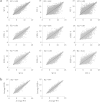Assessment of pleiotropic transcriptome perturbations in Arabidopsis engineered for indirect insect defence
- PMID: 24947327
- PMCID: PMC4091741
- DOI: 10.1186/1471-2229-14-170
Assessment of pleiotropic transcriptome perturbations in Arabidopsis engineered for indirect insect defence
Abstract
Background: Molecular characterization is an essential step of risk/safety assessment of genetically modified (GM) crops. Holistic approaches for molecular characterization using omics platforms can be used to confirm the intended impact of the genetic engineering, but can also reveal the unintended changes at the omics level as a first assessment of potential risks. The potential of omics platforms for risk assessment of GM crops has rarely been used for this purpose because of the lack of a consensus reference and statistical methods to judge the significance or importance of the pleiotropic changes in GM plants. Here we propose a meta data analysis approach to the analysis of GM plants, by measuring the transcriptome distance to untransformed wild-types.
Results: In the statistical analysis of the transcriptome distance between GM and wild-type plants, values are compared with naturally occurring transcriptome distances in non-GM counterparts obtained from a database. Using this approach we show that the pleiotropic effect of genes involved in indirect insect defence traits is substantially equivalent to the variation in gene expression occurring naturally in Arabidopsis.
Conclusion: Transcriptome distance is a useful screening method to obtain insight in the pleiotropic effects of genetic modification.
Figures






Similar articles
-
Transcriptome analysis reveals absence of unintended effects in drought-tolerant transgenic plants overexpressing the transcription factor ABF3.BMC Genomics. 2010 Jan 28;11:69. doi: 10.1186/1471-2164-11-69. BMC Genomics. 2010. PMID: 20105335 Free PMC article.
-
Safety and nutritional assessment of GM plants and derived food and feed: the role of animal feeding trials.Food Chem Toxicol. 2008 Mar;46 Suppl 1:S2-70. doi: 10.1016/j.fct.2008.02.008. Epub 2008 Feb 13. Food Chem Toxicol. 2008. PMID: 18328408 Review.
-
Comparison of salt stress resistance genes in transgenic Arabidopsis thaliana indicates that extent of transcriptomic change may not predict secondary phenotypic or fitness effects.Plant Biotechnol J. 2012 Apr;10(3):284-300. doi: 10.1111/j.1467-7652.2011.00661.x. Epub 2011 Nov 10. Plant Biotechnol J. 2012. PMID: 22070784
-
The stability of the Arabidopsis transcriptome in transgenic plants expressing the marker genes nptII and uidA.Plant J. 2005 Mar;41(6):791-800. doi: 10.1111/j.1365-313X.2005.02350.x. Plant J. 2005. PMID: 15743445
-
Molecular characterization of genetically-modified crops: Challenges and strategies.Biotechnol Adv. 2017 Mar-Apr;35(2):302-309. doi: 10.1016/j.biotechadv.2017.01.005. Epub 2017 Jan 26. Biotechnol Adv. 2017. PMID: 28131814 Review.
Cited by
-
A Comparison of transgenic and wild type soybean seeds: analysis of transcriptome profiles using RNA-Seq.BMC Biotechnol. 2015 Oct 1;15:89. doi: 10.1186/s12896-015-0207-z. BMC Biotechnol. 2015. PMID: 26427366 Free PMC article.
-
CONTRAILS: A tool for rapid identification of transgene integration sites in complex, repetitive genomes using low-coverage paired-end sequencing.Genom Data. 2015 Sep 8;6:175-81. doi: 10.1016/j.gdata.2015.09.001. eCollection 2015 Dec. Genom Data. 2015. PMID: 26697366 Free PMC article.
References
-
- OECD. Consensus document on molecular characterisation of plants derived from modern biotechnology. Ser Harmonisation Regul Oversight Biotechnol. 2010;51:1–30.
-
- Kuiper HA, Kleter GA, Noteborn HPJM, Kok EJ. Assessment of the food safety issues related to genetically modified foods. Plant J. 2001;27(6):503–528. - PubMed
-
- Catchpole GS, Beckmann M, Enot DP, Mondhe M, Zywicki B, Taylor J, Hardy N, Smith A, King RD, Kell DB, Fiehn O, Drapet J. Hierarchical metabolomics demonstrates substantial compositional similarity between genetically modified and conventional potato crops. Proc Natl Acad Sci U S A. 2005;102(40):14458–14462. - PMC - PubMed
-
- Baker JM, Hawkins ND, Ward JL, Lovegrove A, Napier JA, Shewry PR, Beale MH. A metabolomic study of substantial equivalence of field-grown genetically modified wheat. Plant Biotechnol J. 2006;4(4):381–392. - PubMed
-
- Kuiper HA, Kok EJ, Davies HV. New EU legislation for risk assessment of GM food: no scientific justification for mandatory animal feeding trials. Plant Biotechnol J. 2013;11(7):781–784. - PubMed
Publication types
MeSH terms
LinkOut - more resources
Full Text Sources
Other Literature Sources

